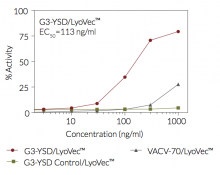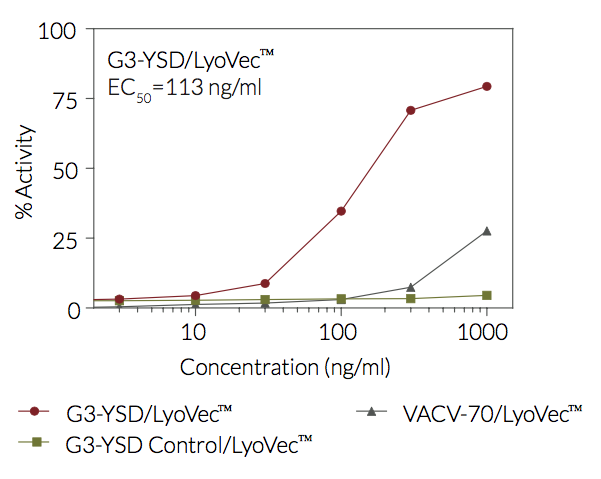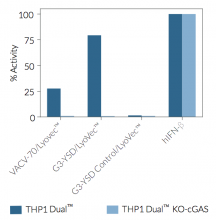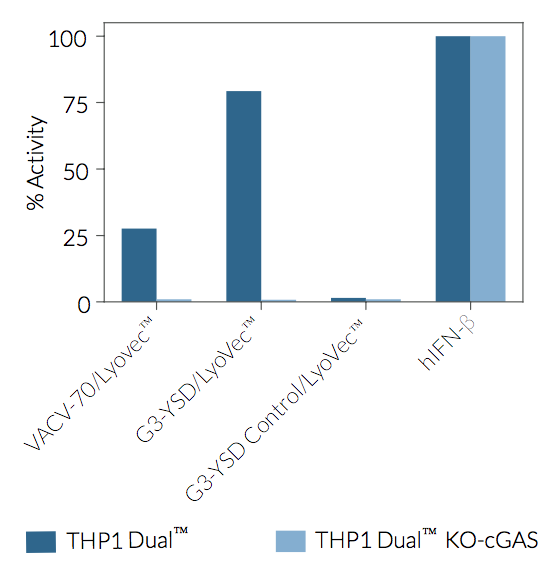G3-YSD
| Product | Unit size | Cat. code | Docs. | Qty. | Price | |
|---|---|---|---|---|---|---|
|
G3-YSD Y-form DNA - cGAS agonist |
Show product |
200 µg |
tlrl-ydna
|
|
G3-ended Y-form Short DNA; cGAS Agonist
G3-YSD is a 26-mer DNA sequence derived from the HIV-1 RNA genome [1]. This short DNA displays a Y-shape arising from its palindromic sequence flanked by unpaired guanosine trimers (G3). The guanosine overhangs in this Y-form DNA have been identified as minimal recognition motifs for cGAS (cyclic GMP-AMP synthase, cGAMP synthase), a critical cytosolic DNA sensor [1].
cGAS detects double-stranded DNA (dsDNA) over 40 bp in length, or stem-loop structures of single-stranded DNA (ssDNA) flanked by unpaired nucleotides [1-3]. Interaction of cGAS with its agonists promotes the synthesis of 2’3’-cGAMP, a second messenger that activates STING (stimulator of interferon genes), and the downstream production of type I interferons (IFNs) and other cytokines [2]. Response to G3-YSD is strictly cGAS-dependent, as demonstrated by the lack of type I IFN production upon intracellular delivery of G3-YSD in cGAS-KO cells [cf. InvivoGen's data hereunder].
![]() Read our review on cytosolic DNA sensors.
Read our review on cytosolic DNA sensors.
References:
1. Herzner AM. et al., 2015. Sequence-specific activation of the DNA sensor cGAS by Y-form DNA structures as found in primary HIV-1 cDNA. Nat Immunol. 16(10):1025-33.
2. Li T. & Chen ZJ., 2018. The cGAS-cGAMP-STING pathway connects DNA damage to inflammation, senescence, and cancer. J Exp Med.
3. Luecke S. et al., 2017. cGAS is activated by DNA in a length-dependent manner. EMBO Rep. 18(10):1707-1715.
Specifications
Activity: cGAS agonist
Working concentration: 100 ng - 1 μg/ml
Sequence: 5’ GGG TATATATATGCATATATATA GGG 3’ (26 mer)
Note: G3-YSD contains a palindromic sequence for which self-hybridization results in double-stranded DNA. The flanking guanosine trimers in 5' and 3' remain unpaired.
Molecular weight: 8088.1 g/mol
Control: G3-YSD Control
Quality control:
- The biological activity has been verified using cellular assays.
- The absence of bacterial contamination, such as lipoproteins and endotoxins, has been confirmed using HEK-Blue™ TLR2 and HEK-Blue™ TLR4 cells.
Contents
- 200 μg G3-YSD (G3-ended Y-form Short DNA)
- 1.5 ml sterile endotoxin-free water
![]() G3-YSD is provided lyophilized and shipped at room temperature.
G3-YSD is provided lyophilized and shipped at room temperature.
![]() Store at -20°C.
Store at -20°C.
![]() Resuspended product is stable for 12 months at -20°C.
Resuspended product is stable for 12 months at -20°C.
![]() Avoid repeated freeze-thaw cycles.
Avoid repeated freeze-thaw cycles.








